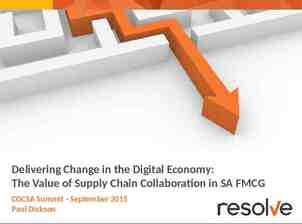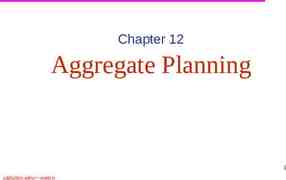BUSINESS DRIVEN TECHNOLOGY Chapter Two: Identifying Competitive
16 Slides1.25 MB
BUSINESS DRIVEN TECHNOLOGY Chapter Two: Identifying Competitive Advantages 2-1
CHAPTER TWO OVERVIEW To survive and thrive an organization must create a competitive advantage – Competitive advantage – a product or service that an organization’s customers value more highly than similar offerings from a competitor – First-mover advantage – occurs when an organization can significantly impact its market share by being first to market with a competitive advantage 2-3
CHAPTER TWO OVERVIEW Organizations watch their competition through environmental scanning – Environmental scanning – the acquisition and analysis of events and trends in the environment external to an organization Three common tools used in industry to analyze and develop competitive advantages include: – Porter’s Five Forces Model – Porter’s three generic strategies – Value chains 2-4
THE FIVE FORCES MODEL – EVALUATING BUSINESS SEGMENTS Organizations use Porter’s Five Forces Model to determine the relative attractiveness of an industry 2-5
Buyer Power Buyer power – high when buyers have many choices of whom to buy from and low when their choices are few – Loyalty programs – reward customers based on the amount of business they do with a particular organization 2-6
Supplier Power Supplier power – high when buyers have few choices of whom to buy from and low when their choices are many – Supply chain – consists of all parties involved, directly or indirectly, in the procurement of a product or raw material 2-7
Supplier Power Organizations that are buying goods and services in the supply chain can create a competitive advantage by locating alternative supply sources (decreasing supplier power) through B2B marketplaces – Business-to-Business (B2B) marketplace – an Internet-based service which brings together many buyers and sellers 2-8
Supplier Power Two types of Business-to-Business (B2B) marketplaces – Private exchange – a single buyer posts its needs and then opens the bidding to any supplier who would care to bid – Reverse auction – An auction format in which increasingly lower bids are solicited from organizations willing to supply the desired product or service at an increasingly lower price 2-9
Threat of Substitute Products or Services Threat of substitute products or services – high when there are many alternatives to a product or service and low when there are few alternatives from which to choose – Switching costs – costs that can make customers reluctant to switch to another product or service 2-10
Threat of New Entrants Threat of new entrants – high when it is easy for new competitors to enter a market and low when there are significant entry barriers to entering a market – Entry barrier – a product or service feature that customers have come to expect from organizations in a particular industry and must be offered by an entering organization to compete and survive 2-11
Rivalry among Existing Competitors Rivalry among existing competitors – high when competition is fierce in a market and low when competition is more complacent Although competition is always more intense in some industries than in others, the overall trend is toward increased competition in just about every industry 2-12
THE THREE GENERIC STRATEGIES – CREATING A BUSINESS FOCUS Organizations typically follow one of Porter’s three generic strategies when entering a new market – Broad cost leadership – Broad differentiation – Focused strategy 2-13
THE THREE GENERIC STRATEGIES – CREATING A BUSINESS FOCUS 2-14
VALUE CHAINS – TARGETING BUSINESS PROCESSES Once an organization chooses its strategy, it can use tools such as the value chain to determine the success or failure of its chosen strategy – Business process – a standardized set of activities that accomplish a specific task, such as processing a customer’s order – Value chain – views an organization as a chain, or series, or processes, each of which adds value to the product or service for each customer 2-15
OPENING CASE STUDY QUESTIONS How Levi’s Got Its Jeans into Wal-Mart 1. Develop a summary of the important elements of the case. 2. How can Levi’s use environmental scanning to gain business intelligence? 3. Using Porter’s Five Forces Model, analyze Levi’s buyer power and supplier power 4. Which of the three generic strategies is Levi’s following? 2-19
Format Report The following HEADINGS must be in the report Summary 30 Environmental Scanning20 Porter’s Five Forces 20 Levi’s Strategy 20 Language/Format 10 2-22





















